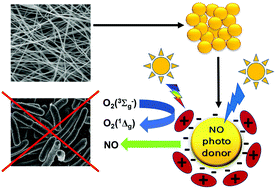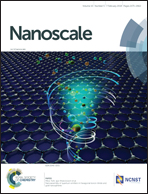Antibacterial nitric oxide- and singlet oxygen-releasing polystyrene nanoparticles responsive to light and temperature triggers†
Abstract
Novel therapies to prevent bacterial infections are of utmost importance in biomedical research due to the emergence of multidrug-resistant strains of bacteria. Herein, we report the preparation, characterization and antibacterial evaluation of sulfonated polystyrene nanoparticles simultaneously releasing two antibacterial species, nitric oxide (NO) and singlet oxygen (O2(1Δg)), upon irradiation with visible light. The nanoparticles were prepared by simple and scalable processes from nanofiber membranes with an encapsulated NO photodonor and/or ionically entangled tetracationic porphyrin/phthalocyanine photosensitizers. The release of NO and O2(1Δg) from the polystyrene nanoparticles is controlled by light wavelength and dose, as well as by temperature, which influences the diffusion coefficient and solubility of both species in the polystyrene matrix. The concentrations of NO and O2(1Δg) were measured by amperometric and time-resolved spectroscopic techniques and by chemical analysis. Due to the efficient photogeneration of both species at physiological temperature and resultant strong antibacterial action observed on Escherichia coli, the nanoparticles are a promising material for antibacterial applications triggered/modulated by light and temperature.



 Please wait while we load your content...
Please wait while we load your content...